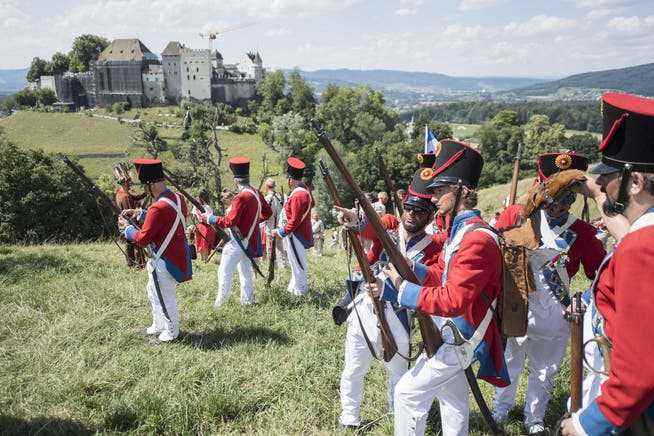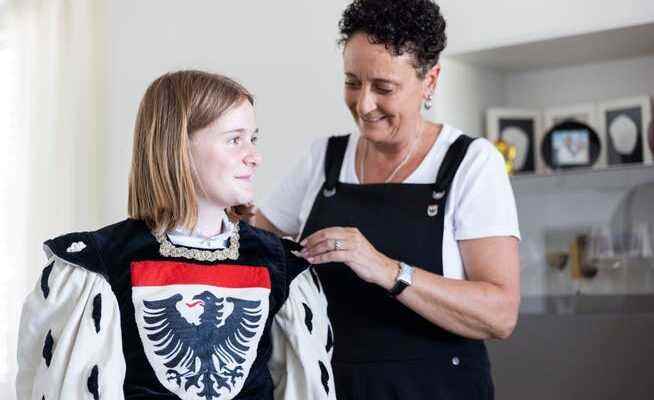The children’s and youth festivals are back after the pandemics – and sometimes get caught between the fronts of traditionalists and progressives.
Youth festivals such as the Aarau Maienzug combine pagan and bourgeois traditions – and always make something new out of them. Student Greta Lorani carried the standard in the parade this year. In the picture at the dress rehearsal with city lady Monika Ramseyer.
It poured like cats and dogs on the first day of July. And yet the whole city of Aarau felt the urge to go outside before 8 a.m. Because the highlight of their year was approaching: the Maienzug, the youth festival, which has about the same importance in the main town of Aargau as the carnival in Basel or the Sechseläuten in Zurich.
And maybe it even meant a little more to some people from Aarau this year: After two years of the pandemic, the beloved festival was back in full force. While the bands played and the fraternities hooted, the schoolchildren marched through the main arteries of the city center – the festive dresses and the wreaths of flowers on their heads packed under capes.
Despite heavy rain, the city, as always, stood guard for its youth. This time they stayed under umbrellas on the sidewalks: the parents taking pictures, the wistful grandmothers and the decked-out upper class in suits and straw hats, keeping watch like a guardian of tradition.
Red carpet instead of rods
The Maienzug is a convivial and social event, half conservative, half boisterous. In historiography it is often attributed to a chastisement measure. Once a year, the students and the teachers cut “Meyen” in the forest and brought it to town in a ceremonial procession – rods that the unruly ones then got to feel during the school year.
A long time ago. Today the red carpet is rolled out for the youngest. They solemnly stroll through the city, which for a short time belongs to them. The move creates a connection to this place, especially for immigrants. Children create memories that will last a lifetime. The adults, on the other hand, often only know fragments of what happened the previous evening, the intoxicated “Beizlifest”.
Ritual, archaic
As in Aarau, youth festivals after Corona will be resumed in many Aargau communities in these weeks. This Friday it took place in Lenzburg, including the biennial Freischaren maneuver on the Goffersberg opposite the castle. The former training fights between volunteers and cadets are recreated in historical robes and with blank cartridges.
The students from the 5th grade each play the disciplined and well-organized cadets. The wild Freischaren consist mainly of adult volunteers. The end is always the same: order triumphs over chaos, the cadets, i.e. the youth, always win. However, in this war year 2022 the maneuver was very controversial. It ended on Friday without a fire in the fortress, but with a reconciliation dance between the two parties in the spirit of peace.

Every two years, the training fights between Freischaren and cadets are recreated in Lenzburg with great effort: A picture from the youth festival 2018.
The youth festivals have a deeply bourgeois core, which is related to the emergence of Helvetic. At the same time, they also have roots that go back much further. These customs are also widespread in the canton of Solothurn and in western Switzerland. In Burgdorf, Solennität, or “Solätte” for short, is also an institution that shouldn’t be missing in any year. The eastern Swiss take it easy. The people of St. Gallen only celebrate their popular children’s festival every three years.
It is different in many Aargau cities such as Brugg, Lenzburg or Aarau. The Maienzug always takes place on the first Friday in July as the end of the school year – and above all as the beginning of the long holidays. It therefore also has something ritualistic about it that is firmly embedded in the processes of this place.
The first evidence of the May procession can be found in the 16th century. The historian Franziska Zaugg from the Universities of Freiburg and Bern therefore suspects that this custom is much older. In her research, Zaugg has specialized in youth cultures and is fascinated by youth festivals. “They are very exciting because they depict a layering of traditions from different centuries,” she says.
flowers and flags
During the youth festivals, the girls parade through the streets with a bouquet in their hands and a wreath on their heads. The city is decorated with flowers or fir branches. This reminds Zaugg of Nordic traditions for the midsummer festival. Therefore, the origin in Switzerland should also be pagan.
At the same time, the influence of the late 18th century is unmistakable. The flags of the town, Switzerland and all cantons hang in the celebrating cities. With the emergence of modern Switzerland from 1798 and the later introduction of compulsory schooling, schools played a central role in these festivals. The institutional component thus came together with the archaic.
It is opposites that unite in these festivals. Zaugg says: “It is interesting that young and old are still enthusiastic about the youth festivals – and not just traditionally minded people, but also progressive families.”
Not tied to gender
The youth festivals and the Maienzug are not entirely popular either. The girls in white skirts, the boys in black trousers and white shirts – these are regulations that can also be irritating in times of gender debates.
That’s why the festivals are also changing, at least in small steps. In Burgdorf, trousers for girls were allowed for the first time at this year’s Solätte. There were also innovations in Aarau. The dress code is no longer tied to gender: either all in white or black trousers and a white top.
The Aargau SP councilor Silvia Dell’Aquila is the first homosexual city councilor in Aarau and has presided over the Maienzugs commission since the beginning of the year. There were some discussions in the run-up to this May procession, she says. Again and again she is asked not to delete a comma in the tradition. Others, on the other hand, wanted to change many things. During the speech, she said: “Some see the May procession as a conservative festival that excludes people. If that’s the case, let’s change it together!”
Bells instead of firecrackers
Dell’Aquila himself comes from a Sicilian immigrant family. In a personal conversation, she says: “The function of a folk festival is to unite all population groups in a respectful togetherness.” But this identity-forming tradition can only stay alive if it goes with society, if it changes.
That is not always easy. Another minor adjustment alongside the gender-neutral dress code, even if it was only intended for this one edition, also prompted discussion this year. On the Maienzug, the city of Aarau is awakened at 7:00 sharp by 23 cannon salutes. However, the committee decided against it this year due to the Ukraine war. As a sign of global peace, however, the city let its church bells ring. “Some didn’t want to let the gun salutes go, others complained that they hadn’t been left out for Syria or Afghanistan,” says city councilor Dell’Aquila. Discussions had taken place that were not appropriate.
On May Day they were forgotten. The bells rang, the parade went through the streets. The pandemic was far away for now. The festival was back.
